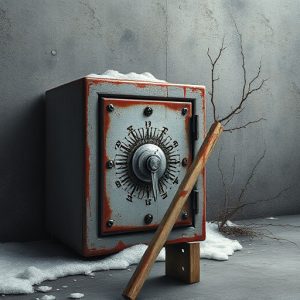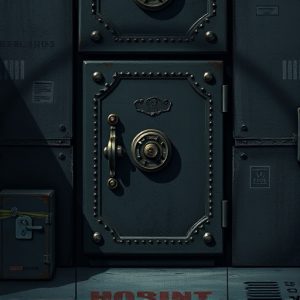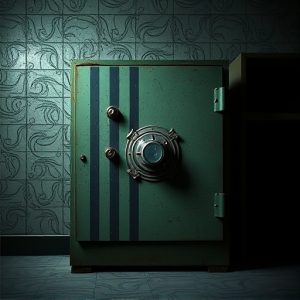Secrets of Hidden Safes: A Historical Journey and Modern Design for Personal Security
Hidden safes in plain sight have been a fusion of architectural design and security for centuries, e…….
Hidden safes in plain sight have been a fusion of architectural design and security for centuries, evolving from ancient treasure protectors to contemporary sanctuaries holding significant historical value. These safes have become synonymous with the human story of valuing and protecting our most treasured possessions, transcending their original role to become historical artifacts in themselves. The discussion delves into their evolution, underscoring their enduring relevance as a symbol of human ingenuity and adaptability in the realm of safety and security. These safes are subtly woven into the fabric of everyday buildings, disguised as unremarkable architectural features like closets or bookcases, with sophisticated security systems that include biometric locks, climate control, and remote access capabilities for seamless integration into modern life. They are fortified with materials resistant to environmental stressors and intruder attempts, featuring the latest technology to ensure comprehensive protection while maintaining an inconspicuous appearance. In contemporary times, hidden safes in plain sight represent a harmonious blend of stealth, functionality, and design, standing as a modern symbol of security within homes and businesses. They are integral to personal security strategies, offering both aesthetic harmony and robust protection, and should be part of a broader security system for optimal safety and preparedness.
Exploring the enigmatic realm of personal security, this article delves into the intricacies of hidden safe rooms—a blend of historical ingenuity and modern innovation. From architectural subtleties that mask their presence to contemporary design advancements, we uncover how these safes have evolved to become discreet guardians of valuables in plain sight. Join us as we traverse the history, identify telltale signs in everyday structures, and understand the artistry behind crafting safe rooms that blend seamlessly with their surroundings. We’ll also examine cutting-edge applications and offer guidance on integrating such secure spaces into your own home or business for enhanced protection.
Unveiling the Secrets of Hidden Safes in Plain Sight: A Historical Perspective
Throughout history, the concept of safety and security has led to the creation of countless hidden safes, cleverly integrated into everyday environments. These secret repositories have been more than mere containers for valuables; they are a testament to human ingenuity in preserving wealth and knowledge. From ancient times to modern day, hidden safes in plain sight have served as a defensive measure against theft, fire, and other calamities. In the past, wealthy individuals and institutions concealed their most precious items within walls or beneath floors, using false compartments and ingenious mechanisms that blended seamlessly with the architecture of homes, libraries, and businesses. Today, these historical safes captivate enthusiasts and historians alike, offering a window into bygone eras where security was as much an art as it was a necessity. The evolution of these hidden safes reflects societal shifts in values, wealth accumulation, and the protection thereof, making them not only repositories for material wealth but also holders of cultural heritage. As one delves into the annals of history, the narrative of hidden safes in plain sight emerges as a thread connecting past and present, revealing how our approach to safeguarding what matters most has been both innovative and enduringly human.
Architectural Subtleties: Identifying Hidden Safe Rooms in Everyday Structures
Architects and designers often incorporate hidden safe rooms into everyday structures with such finesse that their presence is concealed until needed. These covert havens are not merely an afterthought but are carefully integrated into the architectural design, becoming hidden safes in plain sight. The subtlety of these spaces lies in their seamless incorporation into the building’s layout; they blend with existing rooms or common areas so well that they can go unnoticed by the casual observer. The design may involve doors that mimic closet fronts or bookcase openings that swing to reveal a secure entrance. Similarly, windows might appear as architectural elements of the façade rather than points of egress. The use of materials and finishes that match the surrounding environment further obscures their purpose. These secret spaces are often equipped with their own power sources, ventilation systems, and even communications capabilities to ensure they can function independently of the rest of the structure. Recognizing these hidden safes requires a keen eye for detail; one must look beyond the obvious and consider the less apparent aspects of design, such as the way door frames align with floor patterns or how lighting fixtures might cast shadows in unexpected places. By paying attention to these architectural subtleties, it becomes possible to identify hidden safe rooms within what initially appears to be a typical home, office, or commercial building.
The Art of Concealment: Crafting Discreet Safes That Blend With Their Environments
The art of concealment has long been a cornerstone in the design and implementation of hidden safes, with modern iterations reflecting an even greater emphasis on discretion. These safes, known as hidden safes in plain sight, are masterfully crafted to blend seamlessly with their surroundings, often going unnoticed by the casual observer. Architects and safe designers work in harmony to integrate these security measures into residential and commercial spaces, utilizing design elements that mirror the aesthetics of their environment. From the subtle integration within a bookshelf’s false back to the clever use of ornamental features that conceal access points, these safes are a testament to innovation in design and functionality. The materials chosen for these safes are not only visually cohesive but also robust enough to withstand environmental factors and deter potential intruders. This fusion of form and function ensures that the hidden safe remains an unobtrusive guardian of valuables, its presence known only to those initiated into its secrets.
In the realm of high-stakes security, hidden safes in plain sight are not just a design preference but a strategic necessity. These safes are often equipped with advanced features such as biometric locks, climate control systems, and multilayered protection mechanisms. The integration of smart technology within these safes further enhances their discreet nature, allowing for remote monitoring and access while maintaining their inconspicuous exterior. The result is a safe that not only secures assets against theft but also preserves them against the elements, all without compromising the integrity of its environment. The hidden safe in plain sight, therefore, is more than a storage solution; it is a statement of modern security that combines sophistication with the ultimate goal of protection.
Modern Applications and Innovations in Safe Room Design
In recent years, safe room design has evolved significantly, integrating advanced security features and discreet construction to offer homeowners and businesses a secure refuge from various threats. Hidden safes in plain sight have become an innovative aspect of this evolution, expertly camouflaging state-of-the-art storage solutions within unassuming objects. These cleverly designed concealments blend seamlessly with their surroundings, whether it be a wall unit, a piece of furniture, or a specially crafted artwork, ensuring that the valuable contents are safeguarded from prying eyes and potential intruders. The integration of biometric access controls, such as fingerprint scanners and facial recognition technology, adds an additional layer of security, granting access only to authorized individuals. Furthermore, the use of materials like reinforced concrete and ballistic fiber composites in these safe rooms fortifies them against a range of threats, including natural disasters and forced entries. The modern safe room is not just a vault; it’s a sophisticated amalgamation of design and technology that provides security without compromising aesthetics. Innovations such as environmental control systems ensure occupants can remain comfortable and protected for extended periods during crises. These advancements underscore the importance of integrating safety measures into everyday living spaces, making hidden safes in plain sight a prudent choice for those prioritizing personal security and peace of mind.
Personal Security Measures: How to Incorporate Hidden Safes in Your Home or Business
In today’s world, personal security measures are paramount for both residential and commercial properties. One effective strategy to enhance your safety is by incorporating hidden safes in your home or business discreetly. These safes, often referred to as ‘hidden safes in plain sight,’ blend seamlessly with everyday decor, making them unobtrusive and secure. They can be cleverly designed to resemble common household items or architectural elements, thereby maintaining the aesthetic integrity of the space while safeguarding valuables. When selecting a location for your hidden safe, consider areas that receive less foot traffic but are still easily accessible during an emergency. These might include false backs of picture frames, beneath floorboards, within false ceilings, or behind double-sided tape on a wall. The key is to choose a place that you frequently pass by without arousing suspicion.
Installing hidden safes in plain sight isn’t just about concealment; it’s also about selecting high-quality models with robust security features. Opt for safes with reliable locks, preferably combination or biometric options that provide an additional layer of security. Regularly test these mechanisms to ensure they function correctly and consider using reinforced walls or floors to further secure the safe’s location. Additionally, integrate hidden safes into your overall security plan, which might include surveillance systems, alarms, and emergency response protocols. By doing so, you create a comprehensive defense system that deters intruders and protects your most precious assets effectively. Remember to keep any combination or access codes private and to inform trusted family members or employees about the safe’s existence and how to operate it in case of an emergency. With careful planning and execution, hidden safes in plain sight can be a smart addition to your personal security measures, offering peace of mind without compromising on design or functionality.


